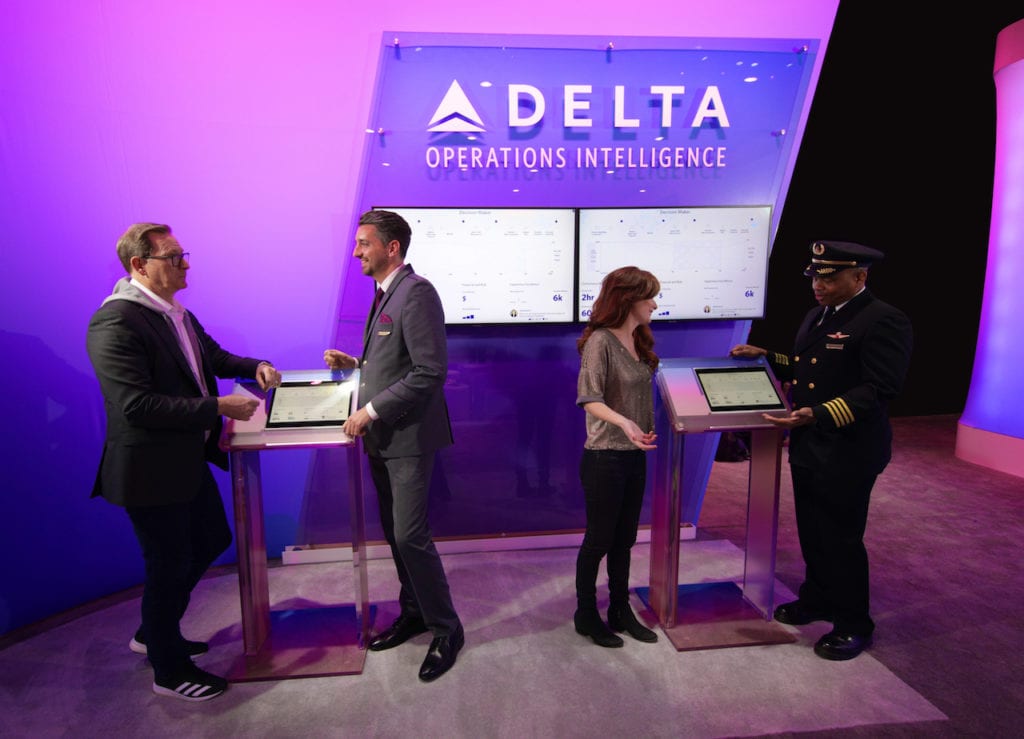
Delta Air Lines plans an initial launch of a new artificial intelligence machine learning tool for spring 2020. Photo: Delta Air Lines
Delta Air Lines CEO Ed Bastian used his keynote speech at the annual Consumer Electronics Show to discuss a new 2020s operational structure for the international carrier that will be driven by the use of a new artificial intelligence (AI) machine learning tool.
Under development at Delta’s operations and customer center, Bastian did not provide a specific product name for the technology, but instead called it a proprietary tool that will mainly be focused on helping passengers and flight crews overcome weather occurrences that impact the routes they fly on a daily basis. The keynote speech is a familiar strategy across all of the divisions of Delta, including their maintenance team whose predictive maintenance leadership gave a speech on how the airline is shifting towards the adoption of AI at the 2019 AEEC/AMC annual conference.
“We’ve cancelled cancellations, but we still have to deal with weather variables like hurricanes or a nasty Nor’easter, and that’s why the team in our operations and customer center is developing the industry’s first machine learning platform to help ensure a smooth operation even in extreme conditions. The system uses operational data to run scenarios and project future outcomes while simulating all the variables of running a global airline with more than 1,000 planes in the sky,” Bastian said.
Initial launch of Delta’s use of the new tool is scheduled for the spring, with the airline describing it as being capable of creating hypothetical outcomes for decision-making that occurs in anticipation of large-scale disruptions caused by weather or other environmental factors beyond their control. A key aspect of the tool is its ability to use machine learning, and learn from the impact of weather disruption so that airline personnel can make better decisions when the same situation occurs in the future.
Neither Bastian or the airline’s media team provided major specific details about what types of specific algorithms their new tool will employ or what types of onboard aircraft systems will help fuel them, however Bastian’s keynote and Delta’s development activity in recent years helps explain how they’re using artificial intelligence. The chief executive’s reference to “cancelling cancellations” can be traced back to Delta’s improvement in avoiding maintenance cancellations, with the airline noting in an October 2019 press release that in 2010 it had more than 5,600 cancellations versus just 55 in 2018 through an internal shift to predictive maintenance.
In 2018 a multi-year agreement was signed between Delta and Airbus for the use of the Skywise Core Platform and Predictive Maintenance Application. Skywise is the data analytics platform Airbus uses to improve flight operational efficiency for airlines, enabled by the Collins Aerospace flight operations and maintenance exchanger (FOMAX) secure server router and compact connectivity unit that gathers aircraft maintenance and performance data and automatically sends it to an airline’s maintenance control center engineers and technicians.
When an aircraft lands, FOMAX uses 4G antennas to transmit all of the performance data about every system on the aircraft to the Skywise analytics platform where it is analyzed and used to develop modeling to predict upcoming system failures. That process can help Delta understand when to replace certain parts before they fail and cause an aircraft on ground situation. In 2019, through November, Delta reported a completion factor of 99.8 percent, according to U.S. Department of Transportation data, including the lowest rate of aircraft maintenance-related cancels in its history.
Delta’s pilots have also developed a flight weather viewer tablet application that gives them a three-dimensional view of their flight path with a prediction of where turbulence will occur. Initial use of turbulence avoidance first emerged for Delta in 2016, when their fiscal year annual report noted pilots were beta testing the use of algorithms developed by the National Center for Atmospheric Research.
Bastian said the airline is still improving on its use of turbulence avoidance and that it will be a major focus of their overall AI and machine learning driven operational structure moving forward.
“Another focus we have is turbulence, we’re seeing more and more instances of it, and it has a very real impact on our customers and on our employees. We have been able to reduce the impact of turbulence with a flight weather viewer, which is an app developed by our very own Delta pilots. It visualizes turbulence and other weather hazards along the flight path. Using it, pilots can adjust their course more precisely,” Bastian said. “It also helps our pilots give real time updates to travelers while they’re in the air in advance of encountering turbulence and can also let them know how long we expect it to last.
A key aspect of the new AI tool is that it is proprietary, using Delta’s internally held historical operational data to simulate the outcomes of certain environmental impacts on flight operations in real time. Erik Snell, senior vice president of Delta’s operations and customer center, said in a statement that the carrier is adding a “machine learning platform to our array of behind-the-scenes tools so that the more than 80,000 people of Delta can even more quickly and effectively solve problems even in the most challenging situations.”
Among the variables considered by the machine learning algorithm of the new tool range from aircraft placement and crew restrictions to “geopolitical constraints.” Their smartphone mobile application will also play a major role in their adoption of AI, according to Snell.
“As the Fly Delta app transforms into a day-of-travel digital concierge, we expect our quicker game-time decisions to play an even greater role in providing a more stress-free travel experience for our customers,” Snell said.